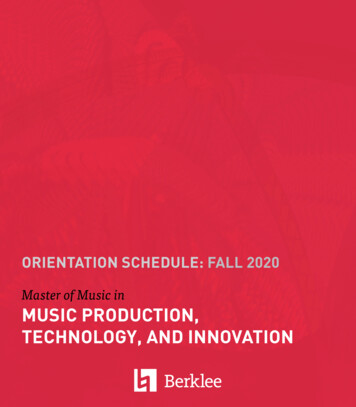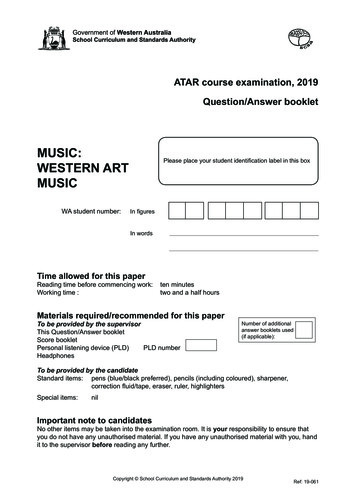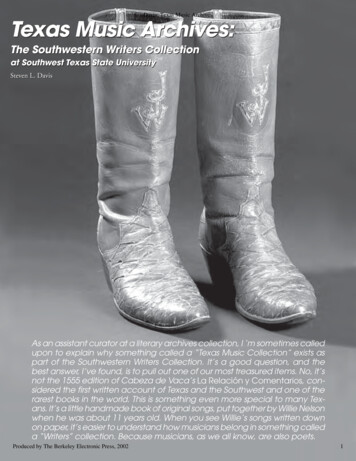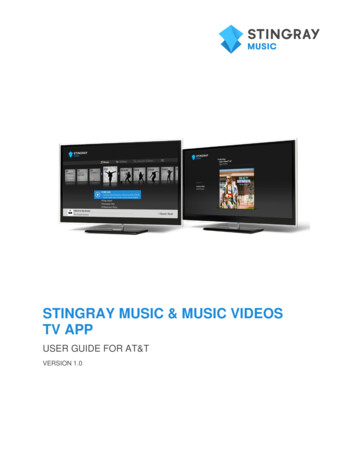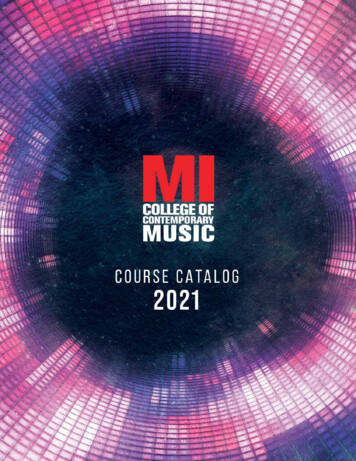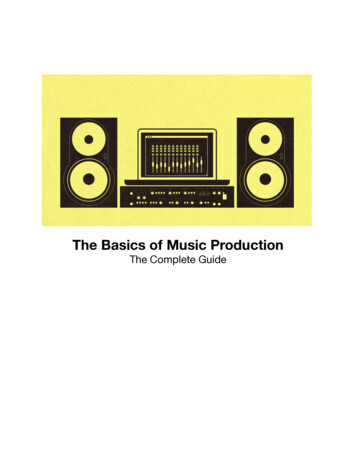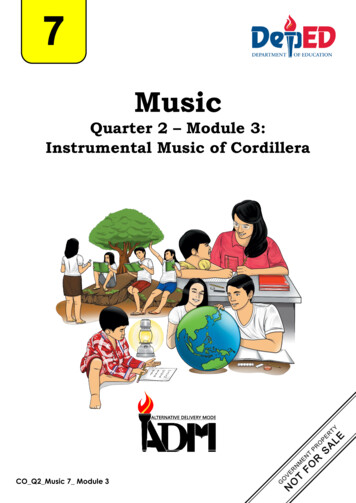
Transcription
MusicQuarter 2 – Module 3:Instrumental Music of CordilleraCO Q2 Music 7 Module 3
Music – Grade 7Alternative Delivery ModeQuarter 2 – Module 3: Instrumental Music of CordilleraFirst Edition, 2020Republic Act 8293, section 176 states that: No copyright shall subsist in any work ofthe Government of the Philippines. However, prior approval of the government agency or officewherein the work is created shall be necessary for exploitation of such work for profit. Suchagency or office may, among other things, impose as a condition the payment of royalties.Borrowed materials (i.e., songs, stories, poems, pictures, photos, brand names,trademarks, etc.) included in this module are owned by their respective copyright holders.Every effort has been exerted to locate and seek permission to use these materials from theirrespective copyright owners. The publisher and authors do not represent nor claim ownershipover them.Published by the Department of EducationSecretary: Leonor Magtolis BrionesUndersecretary: Diosdado M. San AntonioDevelopment Team of the ModuleAuthor:Evangeline L. De LeonContent Editor:Emmanuel C. AlveyraLanguage Editors:Cherrie Rose L. Desaliza, Gladys F. CantosReviewer:Emmanuel C. AlveyraIllustrator:Reymark L. Miraples, Louie J. Cortez, Richard Amores,Pablo M. Nizal, Jr., Jan Christian D. CabarrubiasLayout Artist:Reymark L. Miraples, Jhunness Bhaby A. VillalobosManagement Team: Benjamin D. Paragas, Mariflor B. Musa, Melbert S. Broqueza,Danilo C. Padilla, Annabelle M. Marmol, Florina L. Madrid,Norman F. Magsino, Dennis A. Bermoy, Emmanuel C. AlveyraPrinted in the Philippines byDepartment of Education – MIMAROPA REGIONOffice Address: Meralco Avenue, Cor. St. Paul Road, Pasig City, Metro ManilaTelephone: (02)863 - 14070E-mail Address:: clmd.depedro4b@gmail.com
7MusicQuarter 2 – Module 3:Instrumental Music of Cordillera
Introductory MessageThis Self-Learning Module (SLM) is prepared so that you, our dear learners,can continue your studies and learn while at home. Activities, questions, directions,exercises, and discussions are carefully stated for you to understand each lesson.Each SLM is composed of different parts. Each part shall guide you step-bystep as you discover and understand the lesson prepared for you.Pre-tests are provided to measure your prior knowledge on lessons in eachSLM. This will tell you if you need to proceed on completing this module or if youneed to ask your facilitator or your teacher’s assistance for better understanding ofthe lesson. At the end of each module, you need to answer the post-test to self-checkyour learning. Answer keys are provided for each activity and test. We trust that youwill be honest in using these.In addition to the material in the main text, Notes to the Teacher are alsoprovided to our facilitators and parents for strategies and reminders on how they canbest help you on your home-based learning.Please use this module with care. Do not put unnecessary marks on any partof this SLM. Use a separate sheet of paper in answering the exercises and tests. Andread the instructions carefully before performing each task.If you have any questions in using this SLM or any difficulty in answering thetasks in this module, do not hesitate to consult your teacher or facilitator.Thank you.
Lesson1Instrumental Musicof CordilleraLearning CompetenciesThe learner:1. describes the musical elements of some vocal and instrumental selectionsfrom Cordillera, Mindoro, Palawan and of the Visayas after listening; (MU7LVIIa-f-2)2. discover ways of producing sounds on a variety of sources similar toinstruments being studied; (MU7LV-IIb-g-4)3. improvises simple rhythmic/melodic accompaniments to selected music fromthe Cordillera, Mindoro, Palawan and of the Visayas; and (MU7LV-IIb-g-5)4. performs music from Cordillera, Mindoro, Palawan and of the Visayas withaccompaniment. (MU7LV-IIb-g-6)What I Need to KnowIgorot tribe playing gangsa, tongatong and bungkaka ( from left to right)This module will open your awareness about the instrumental music ofCordillera, its function and distinct characteristic. You will also discover how theCordilleras express their feelings towards each other and the environment, theirhistory, and their supernatural beliefs through the medium of the musicalinstruments. A variety of activities and performances such as improvisation andcreations of rhythmic pattern and the like will be provided to stimulate your creativityand resourcefulness. You will also analyze and evaluate performances which will inturn lead you to a greater understanding of the culture and traditions of Cordillerapeople. It is expected therefore that you will undertake all the activity seriously andresponsibly. Have fun and enjoy your journey.1CO Q2 Music 7 Module 2
Learning ObjectivesIn this module, you will travel to the fascinating world of instrumental musicof Cordillera people. You will be amazed as to how their musical instruments reflecttheir way of life and their relationship to nature. Through this lesson, you will alsodiscover how the Cordilleras express their feelings towards each other and theenvironment, their history, and their supernatural beliefs through the medium of thevoice and/or musical instruments.Moreover, at the end of this lesson, you are expected to:1. distinguish the distinct characteristics of Cordillera Instrumental musicspecifically the gangsa ensemble and the Bamboo solo/ensemble;2. classify the musical instruments of Cordillera using the Hornbostel-Sachsclassification;3. analyze the elements of music that is uniquely embodied in CordilleraInstrumental Music;4. improvise percussion instruments using materials from the environment; and5. create a rhythmic pattern following the style of Cordilleran instrumentalmusic.What I KnowDirections: Read the questions carefully. Identify the appropriate words/conceptfitted to the description. Choose your answer from the words after the question.Do this in your activity notebook.1. How is gangsa toppaya performed?A. Gongs are struck with a wooden mallet.B. Players/musicians are on standing position.C. Gongs are played with the palm.D. Gongs are played with drums stick.2. Which of the following best described Saggeypo?A. It is a bamboo pipes closed at one end by a node.B. It is a nose flute with a long and narrow internal diameter.C. It is composed of 5-8 pipes.D. It is a transverse flute.3. How is Gangsa described?A. It is a tenor drum of the Igorot.B. It is a hand-held smooth-surface gong with a narrow rim.C. It is made of bamboo cut in various length.D. It is a bass drum of the Ifugao2CO Q2 Music 7 Module 2
4. The following are the instruments in the gangsa ensemble EXCEPT:A. five to six flat gongsB. five to eight pipesC. a bamboo flute and drumsD. None of the above5. This musical instrument of Cordillera is also known as Kubing or Jew’sHarp.A. UllibawB. PatetegC. BilbilD. Pateteg6. What is love incantations?A. It is a love ritual for a decease ancestor.B. It is a song -debate vocal ensemble.C. It is a ritual chanting of words purporting to have magical powers.D. It is a funeral song7. Music performances of Cordillera are link on the following events EXCEPT:A. Birth, wedding and funeralB. Prayer to the godsC. Theater performancesD. Peace, agreement and covenant8. Which of the instruments below are used to accompany the vocal ensembleof Cordillera?A. Pateteg and UlibawB. Kuglong and SaluroyC. Tongatong and BilbilD. Gangsa and Kuglong9. Which of the following is an example of love incantations of the Cordillera.A. HudhudB. BadiwC. SalidumayD. Oggayam10. What are the two distinct sound characteristics of Cordillera instrumentalmusic?A. Metal and Bamboo instrumentsB. Bamboo and Wood instrumentsC. Metal and Stones instrumentsD. Stones and Bamboo instruments3CO Q2 Music 7 Module 2
11. How is Gangsa Pallok played?A. Gongs are beaten with bare handsB. Gongs are played by striking each otherC. Gongs are struck with wooden malletsD. Gongs are scratch using a metal.12. Which of the following statements best described Diwdiw-as?A. It is played by striking with the palms.B. It produces notes in a range of two and a half octaves.C. It produces sound with varying pitch.D. It gives sound by plucking the instruments.13. The following are bamboo percussion instruments of Cordillera EXCEPT:A. KollitongB. TongatongC. BungkakaD. Pateteg14. How is Bungkaka or Bilbil described?A. It is a Kalinga bamboo buzzer used by womenB. It is played by striking it on the open palm.C. It is A and BD. It is played by stamping each against the ground.15. Which of the following best described Pateteg?A. It is a Kalinga leg xylophone ensemble instrument.B. It consists 10 bamboo blades in graduated sizes.C. It is a Kalinga bamboo pipes.D. It is played by holding the end of the tube with one hand.4CO Q2 Music 7 Module 2
What’s InIn the previous module you’ve learned the characteristic of vocal music,representative music and/or repertoire and the performance practices from theHighlands of Luzon (Cordillera Region).This time, test is provided to assess the understanding you have acquired onvocal music of Cordillera. Answer this in your activity notebook. Good luck and havefun.Activity #1: Do You Still Remember Me?Directions: Fill in the blanks with correct terms/concept related to vocal music ofCordillera. Choose your answer from the box. Do this in your activity notebook.BadiwcommunalMelismatic singingIgorot1.Hudhudoral traditionsSalidumayIfugao's Hudhud chantOggayamchantingis a love incantation vocal ensemble -combination of vocaland instrumental music.2.is the oldest traditional Cordilleran way of storytelling in theform of chant.3.is a festive, declaratory and chant song conveying greetingsand expression of opinions related to the events.4.is performed in leader-chorus style that usually lasts forthree to four days.5.are group of indigenous people known for their unique vocaland instrumental music.6.is threatened and inscribed in the 2008 List of IntangibleCultural Heritage of Humanity.7.is a style of performance in group where everyone is enjoinedto showcase their talents in singing8. Cordilleras preserved and transmitted their musical cultures and traditionsfrom generation to generation through.9.is a style of reciting/singing in a monotonous repetitive tone.10.is a group of notes or tones sung in one syllable in plainsong.5CO Q2 Music 7 Module 2
What’s NewCordillera meaning ‘knotted rope’ is the only country’s landlocked region. Ithosts nine major rivers that provide continuous water for irrigation and energy inneighboring provinces. Its rugged terrain and mountainous breathtaking topographyhave been home to the sturdy and industrious indigenous tribes collectively calledthe Igorot. It has many spectacular scenic views and enchantingly cool places. Theregion is a place where several ethno linguistic groups live. It consists of theprovinces of Abra, Apayao, Benguet, Ifugao, Kalinga, Mountain Province and Apayao.In spite of their differences in language, it did not lead them to variations in culturaldevelopment.Cordillera region is rich in ancient culture and known for its unique vocal andinstrumental music. Vocal music reflects the way of life of the Cordillera peoplethrough themes about nature, family life, work in the field, as well as the spiritualmatters. On the other hand, instrumental music is a composition or recordingwithout lyrics and made solely for instruments. Cordillera instrumental music isdistinctively made up of two sound characteristics based on their respectivematerials. The first one is made of bamboo (flutes and percussion instruments),while the second is made of metal (gongs). These traditions however, are on theirway to extinction due to several factors. Some of these are modernization, conflictbetween state policies and their ancestral rights on land ownership, mega tourism,militarization, and the shift from manual farming to machine-processed farming. Inaddition to these, few of the young generation today are taught and learned thetraditional music of their forefathers. In this regard, this module is written for you tofully understand, embrace, preserve and cultivate our cultures and traditions.Welcome to the first part of your lesson about instrumental music ofCordillera. Various activities and challenges are on the way for you to uncover yourprevious understanding and knowledge of the lesson. Be reminded that you have toaccomplish all the activities before going to the next stage. Are you ready? You maynow begin your search here. Feel free and have fun.6CO Q2 Music 7 Module 2
Activity #2: Getting To KnowAre you familiar with the following instruments? This task will activate yourprior knowledge about the instrumental music of Cordillera.Directions: Look closely at each picture and try to guess the material from which itis made and how it is played. Classify them also according to Hornbostel SachsSystem (Aerophone, Chordophone, Membranophone, or Idiophone). Write thumbs upif you think you can play it and thumps down if not. Copy the table and write youranswer in your notebook.MusicalInstrumentsMaterials it ismadeHow it isplayedClassificationThumbs up/Thumbs down1. Gangsa2. bungkaka3. tongali4. tongatong7CO Q2 Music 7 Module 2
MusicalInstrumentsMaterials it ismadeHow it isplayedClassificationThumbs up/Thumbs down5. diwdiwas6. solibao7. kulitong8. Ulibaw orJew’s Harp9. Gong(Cordillera)10. pateteg8CO Q2 Music 7 Module 2
1. What is Cordillera instrumental music?2. What are the unique characteristics of Cordillera instrumental music?3. What did you observe about the materials used in the creation of their musicalinstruments? Is there a relationship with their culture? If yes, kindly explainyour answer.4. In two to three sentences make a summary of your realization about Cordillerainstrumental music.Activity #3: Draw My MusicDirections: In your activity notebook create a colorful, attractive design of GraffitiW
Use a separate sheet of paper in answering the exercises and tests. And read the instructions carefully before performing each task. If you have any questions in using this SLM or any difficulty in answering the tasks in this module, do not hesitate to consult your teacher or facilitator. Thank you. 1 CO_Q2_Music 7_ Module 2 Lesson 1 Instrumental Music of Cordillera Learning Competencies The .


